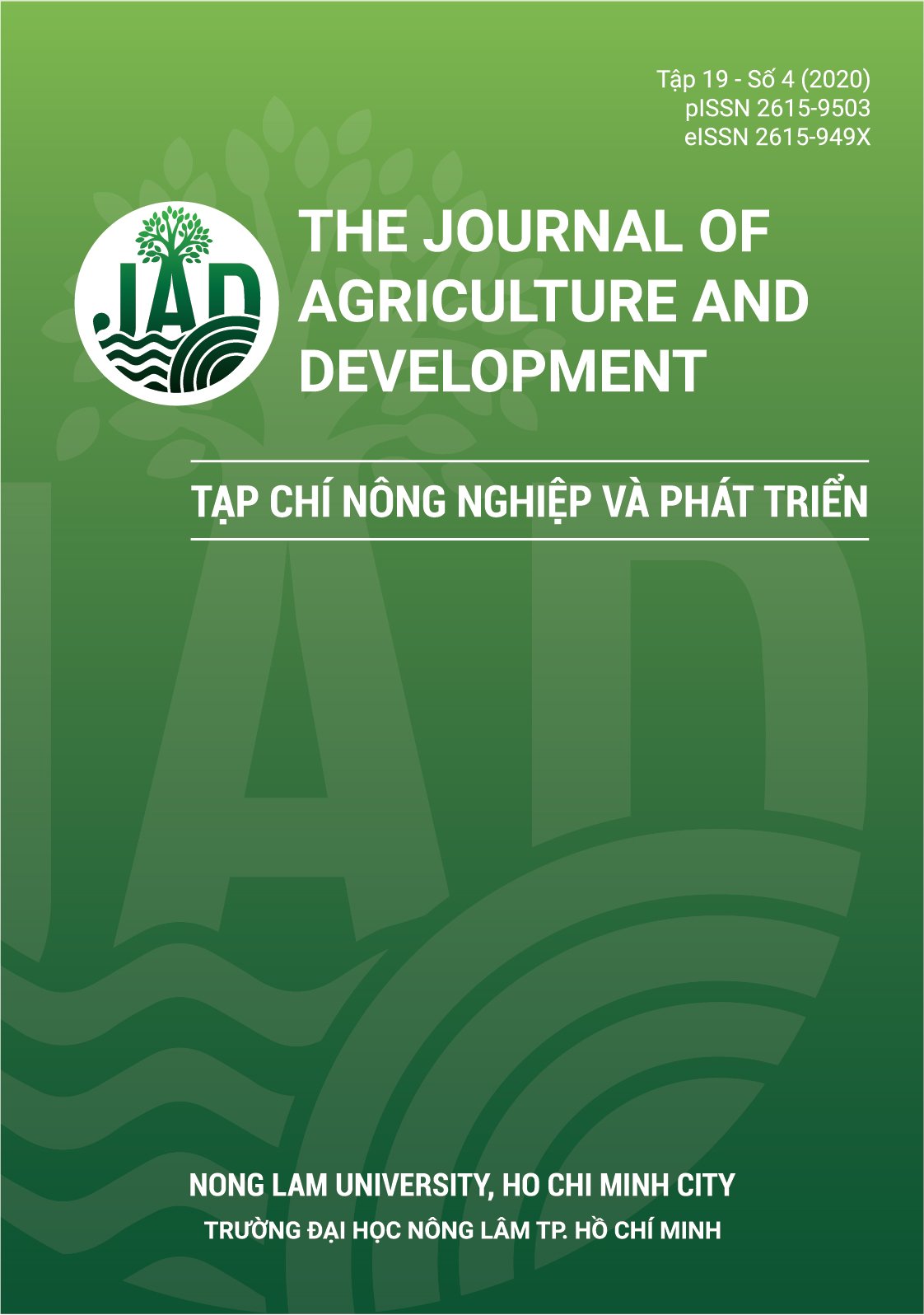Microencapsulation of Gac (Momordica cochinchinensis Spreng.) fruit oil in Ca-Alginate bead produced through Jetcutter
Main Article Content
Abstract
The Gac (Momordica cochinchinensisSpreng.) fruit oil was microencapsulated in Ca-Alginate bead by Jetcutter equipment. Experiments showed that the effects of emulsion preparation and equipment parameters were significant on particle size, microencap-sulation yield, loading capacity and solids recovery efficiency of the device. At alginate concentration of 2.5%, the bead had a spherical size of 1.07 - 1.18 mm when the fluid flow was 14 mL/min and the rotation of the cutting disc was 400 - 800 rpm. Samples stored for 2 h after homogenization showed better microencapsulation yield (83 - 84%) and bead size (1.07 mm) than those stored for 24 h after homogenization (79% and 1.18 mm). When the loading capacity increased from 20% to 40%, the mole ratio (CaCl2-alginate) in the bead was reduced from 1.55 to 0.86. This mole ratio data can be considered to control and adjust CaCl2 concentration during the continuous operation of the Jetcutter.
Article Details
References
Abdul-Hammed, M., Bello, I, A., & Oladoye, S. O. (2013). Simultaneous spectrophotometric determination of lycopene and beta-carotene concentrations in carotenoid mixtures of the extract of tomatoes, papaya and orange juice. Pakistan Journal of Scientific and Industrial Research 56(2), 90-97. https://doi.org/10.52763/PJSIR.BIOL.SCI.56.2.2013.90.97
Chan, E. S. (2011). Preparation of Ca-Alginate beads contain-ing high oil content: Influence of process variables on encapsulation efficiency and bead properties. Carbo-hydrate Polymers 84(4), 1267-1275. https://doi.org/10.1016/j.carbpol.2011.01.015
Chan, E. S., Lee, B. B., Ravindra, P., & Poncelet, D. (2009). Prediction models for shape and size of ca-alginate macrobeads produced through extrusion–dripping method. Journal of Colloid and Interface Science 338(1), 63-72. https://doi.org/10.1016/j.jcis.2009.05.027
Fundueanu, G., Nastruzzi, C., Carpov, A., Desbrieres, J.,& Rinaudo, M. (1999). Physico-chemical characteriza- tion of Ca-alginate microparticles produced with different methods. Biomaterials 20(15), 1427-1435. https://doi.org/10.1016/S0142-9612(99)00050-2
Martins, I. M., Maria, F. B., Manuel, C., & Alírio, E.R. (2014). Microencapsulation of essential oils with biodegradable polymeric carriers for cosmetic applications. Chemical Engineering Journal 245, 191-200. https://doi.org/10.1016/j.cej.2014.02.024
Mercadante, A. Z., & Rodriguez-Amaya, D. B. (1998). Effects of ripening, cultivar differences, and processing on the carotenoid composition of mango. Journal of Agricultural Food Chemistry 46(1), 128-130. https://doi.org/10.1021/jf9702860
Mohsenin, N. N. (1970). Physical Properties of Plant and Animal Materials (1st ed.). London, England: Gordon and Breach Science Publishers. https://doi.org/10.4324/9781003062325
Paulo, B. B., Ramos, F. de M., & Prata, A. S. (2017). An investigation of operational parameters of jet cutting method on the size of Ca-alginate beads. Journal of Food Process Engineering 40(6), e12591. https://doi.org/10.1111/jfpe.12591
Prüße, U., J¨org, D., Ju¨rgen, B., & Klaus-Dieter, V. (2000). Production of spherical beads by JetCutting. Chemical Engineering & Technology 23(12), 1105-1110. https://doi.org/10.1002/1521-4125(200012)23:12<1105::AID-CEAT1105>3.0.CO;2-V
Pru¨ße, U., Luca, B., Marek, B., Branko, B., Jozef, B., Peter, G., Dorota, L., Verica, M., Benjamin, M., Clau- dio, N., Viktor, N., Poncelet, D., Swen, S., Lucien, T., Azzurra, T., Alica V., & Klaus-Dieter V. (2008). Comparison of different technologies for alginate beads production. Chemical Papers 62(4), 364-374. https://doi.org/10.2478/s11696-008-0035-x
Pru¨ße, U., Ulrich, J., Peter, W., Ju¨rgen, B., & Klaus- Dieter, V. (2002). Bead production with JetCutting and rotating disc/nozzle technologies. Landbauforschung Volkenrode Sonderheft 241, 1-10.
Soliman, E. A., El-Moghazy, A. Y., El-Din, M. S. M., & Massoud, M. A. (2013). Microencapsulation of essential oil within alginate: Formulation and in vitro evaluation of antifungal activity. Journal of Encapsulation and Adsorption Sciences 3, 48-55. https://doi.org/10.4236/jeas.2013.31006
Tan, B., & Soderstrom, D. N. (1989). Qualitative aspects of UV-vis spectrophotometry of beta-carotene and ly- copene. Journal of Chemical Education 66(3), 258. https://doi.org/10.1021/ed066p258
Truong, V. (2020). Report of Project B2018-NLS13 funded by Ministry of Education and Training of Vietnam. Ho Chi Minh City, Vietnam.
Truong, V., Nguyen, P. T., Ta, P. N. M., Nguyen, P. T., & Pham, N. T. C. (2020). Effects of type and concentration of alginate on microencapsulation characteristics of lime essential oil (Citrus aurantifolia) produced by extrusion-dripping methods. The Journal of Agriculture and Development 19(1), 65-76. https://doi.org/10.52997/jad.9.01.2020
Xiao, Z., Wanlong, L., Guangyong, Z., Rujun, Z., & Yun- wei, N. (2013). A review of the preparation and application of flavour and essential oils microcapsules based on complex coacervation technology. Journal of the Science of Food and Agricultre 94(8), 1482-1494. https://doi.org/10.1002/jsfa.6491








